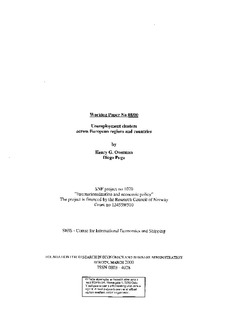| dc.contributor.author | Overman, Henry G. | |
| dc.contributor.author | Puga, Diego | |
| dc.date.accessioned | 2006-08-23T10:42:18Z | |
| dc.date.available | 2006-08-23T10:42:18Z | |
| dc.date.issued | 2000-03 | |
| dc.identifier.issn | 0803-4028 | |
| dc.identifier.uri | http://hdl.handle.net/11250/165900 | |
| dc.description.abstract | European regions experienced a polarisation of their unemployment rates between 1986 and 1996. Regions with high or low initial unemployment saw little change, while regions with intermediate unemployment moved towards more extreme rates. This polarisation was driven by employment changes. Labour force changes partly mitigated polarisation. We develop a non-parametic approach to show that unemployment rates are more similar across neighbouring regions than across regions in the same State or with similar characteristics. Regardless of their initial position, regions experienced similar changes to those of neighbours. Surprisingly, this similarity persists after controlling for common characteristics, and is equally strong across national borders. | en |
| dc.format.extent | 4679985 bytes | |
| dc.format.mimetype | application/pdf | |
| dc.language.iso | eng | en |
| dc.publisher | SNF | en |
| dc.relation.ispartofseries | Working paper | en |
| dc.relation.ispartofseries | 2000:8 | en |
| dc.subject | uneployment | en |
| dc.subject | European regions | en |
| dc.subject | distribution dynamics | en |
| dc.title | Unemployment clusters across European regions and countries | en |
| dc.type | Working paper | en |
